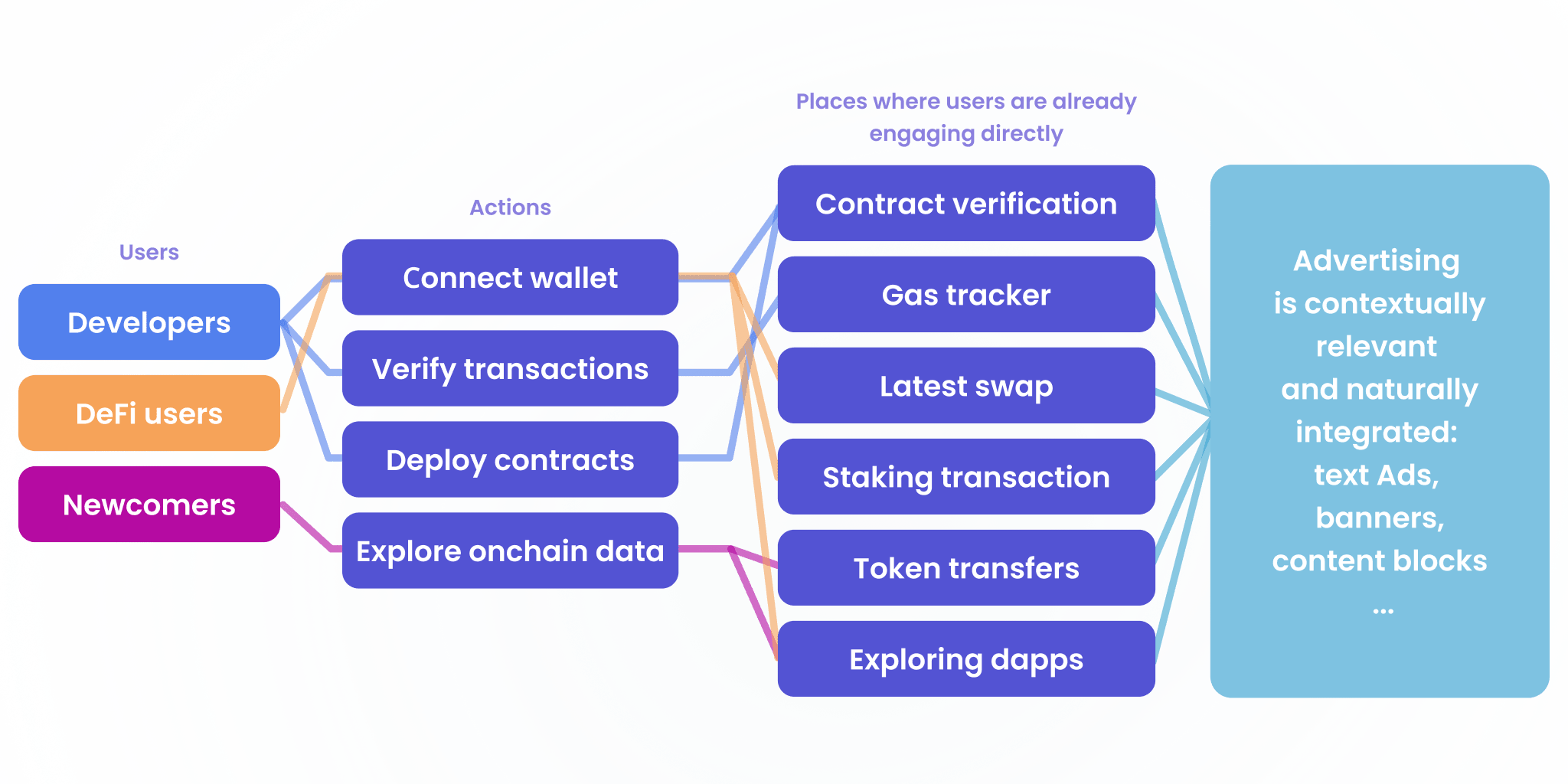Crypto Ad Networks: How to Reach Web3 Audiences
Learn how to reach Web3 users with crypto-native advertising networks. Compare platforms like Blockscout, Slise, Specify, and Coinzilla, and discover how onchain ad placements connect you directly to active blockchain audiences.

Most marketers understand how to run paid campaigns on Google or Meta. But when it comes to blockchain projects, those same tools fall short. Ads for tokens, Dapps, or DeFi platforms are often restricted or underperform because they’re not reaching people who actually use Web3.
That’s where crypto ad networks come in.
They give projects a way to reach verified blockchain users. People who actually explore networks, check transactions, trade, stake, or build. Instead of broad demographics, these networks tap into onchain behavior and ecosystem context.
For advertisers, this means campaigns can appear where intent already exists: on crypto websites, Dapp directories, and increasingly, inside block explorers themselves.
This guide explains what Web3 ad networks are, how they work, and how to choose one that fits your project’s goals. It also covers how Blockscout, the open-source block explorer powering over 3,000 EVM chains, provides a native way to reach crypto audiences directly at the source.
What Is a Web3 Ad Network?
A Web3 ad network connects blockchain projects with audiences across crypto-native websites, platforms, and apps. Think of it as a specialized ecosystem for reaching users who already hold tokens, interact with wallets, or explore onchain data.
Unlike traditional ad platforms, which rely on generalized browsing behavior, crypto ad networks work within blockchain environments. They’re designed for the realities of decentralized ecosystems, multiple chains, active wallet users, and niche communities built around protocols and Dapps.
Most networks in this category provide:
- Display and native ads on crypto sites and applications
- Wallet or chain-level targeting to focus campaigns on relevant audiences
- Transparency in impressions and engagement metrics
- Flexible pricing models like CPM or CPC
For Web3 teams, this model means advertising to users who already understand blockchain. Whether your goal is awareness, sign-ups, or active wallet connections, a Web3 ad network gives you a cleaner path to those users than general-purpose platforms ever could.
How to Choose the Right Crypto Ad Network
There are now dozens of platforms describing themselves as Web3 or crypto ad networks, but not all deliver the same quality of reach. Here are some practical considerations when evaluating one for your project.
1. Real crypto-native traffic
Check whether the network’s impressions come from verified crypto websites, explorers, or Dapp directories. The best-performing campaigns run in active blockchain environments, not borrowed traffic from generic ad exchanges.
2. Chain or category targeting
If your app or protocol is on a specific chain like Ethereum, Ink, or Optimism for example, it’s best to choose an ad network that lets you advertise within that ecosystem. Some networks, including Blockscout, even support targeting by explorer or chain family, aligning campaigns directly with your user base.
3. Placement context
Visibility matters most when it matches intent. Ads served beside token lists, transaction explorers, or developer tools are seen by people already in discovery mode, making them more likely to click or engage.
4. Cost and flexibility
Pricing can vary widely between networks. CPM models work best for awareness; CPC or CPA may suit performance-driven campaigns. Evaluate where you’ll get consistent visibility for your spend, not just the lowest rate.
Why Advertising to Web3 Users Works Differently
Most advertising platforms are designed for passive browsing. They track what people read, watch, or click, but they rarely capture what people do.
In Web3, it’s the opposite. Actions are everything.
Users don’t just scroll or shop. They connect wallets, verify transactions, deploy contracts, and explore onchain data. Every one of those moments is defined by intent.

That’s why blockchain display ads tend to perform best when they appear in high-intent environments i.e. places where users are already engaging directly with the network.
For example:
- Developers checking contract verification or gas trackers on an explorer.
- DeFi users reviewing their latest swap or staking transaction.
- Newcomers looking up token transfers or exploring Dapps.
In each case, attention is focused and purpose-driven. Showing up in that moment, within an explorer interface or integrated dashboard isn’t perceived as an interruption. It’s contextually relevant.
That’s the fundamental difference between Web2 advertising and onchain advertising. The former interrupts; the latter is more naturally integrated.
Comparing Leading Web3 Ad Networks
The Web3 advertising landscape has evolved rapidly over the past few years. What started as a handful of niche display networks has expanded into a set of integrated digital marketing tools rather strictly competing platforms. Most networks today serve distinct roles: some focus on media reach, others on creative optimization, and some, like Blockscout, provide direct visibility inside onchain environments.

For advertisers, these options are complementary. Running campaigns across several networks can maximize both offchain visibility and onchain engagement, creating a complete funnel from awareness to interaction.
Below is an overview of several networks commonly used by blockchain teams today, including those integrated with or supported across Blockscout’s own ecosystem:
Slise
Reach & Focus: Network of crypto and Web3 publishers.
Key Features: Privacy-forward architecture, wallet-based segmentation, and real-time dashboards.
Common Use Cases: Display campaigns targeting active crypto readers.
Specify
Reach & Focus: Creative and performance-focused ad platform.
Key Features: Smart-contract-enabled delivery, adaptive creative optimization, and integrated analytics.
Common Use Cases: Visual and creative optimization for multichain Web3 campaigns.
Coinzilla
Reach & Focus: Established crypto ad network with global scale.
Key Features: 1 000+ publisher sites, native and banner ads, PR marketplace and sponsored content options.
Common Use Cases: Awareness and credibility campaigns across major crypto media and exchanges.
Blockscout
Reach & Focus: Native ad placements across 3 000+ EVM explorers and rollups.
Key Features: Display ads, text placements, newsletter sponsorships, and analytics integrations.
Common Use Cases: crypto-native campaigns reaching Web3 users at the point of interaction.
Each of these platforms contributes to a more mature Web3 marketing stack. In many cases, advertisers use several together. For example, running display campaigns via Slise or Coinzilla, while adding crypto newsletter placements and sponsored blog articles through Blockscout block explorers for broader visibility.
This blended approach helps projects balance reach, relevance, and credibility: broad visibility from major crypto media networks, combined with onchain engagement directly inside Blockscout’s explorer environment.

Advertising with Blockscout
Blockscout is more than a block explorer. It’s the open-source foundation powering over 3,000 EVM-compatible networks, from major well-established chains like Arbitrum and Base to newer L2s, sidechains, and appchains. That footprint makes Blockscout one of the largest discovery surfaces in the blockchain ecosystem.
Explore 3,000+ Chains
Blockscout powers the largest network of open-source block explorers - Chainscout brings them all together in one place for a single view of the onchain landscape.
Check ChainscoutFor advertisers, this means a direct line to millions of real Web3 users: developers, traders, and newcomers who already engage onchain every day. Campaigns can appear in the exact environments where users check transactions, verify contracts, and explore tokens, making Blockscout’s ad placements uniquely relevant and high-intent.
Ad Options Available
Blockscout’s native advertising options are built to fit naturally within the explorer environment and communication channels
Explorer Display Ads
Visual placements within explorer interfaces, ideal for promoting launches, tokens, or Dapps. These appear alongside live transaction data where engagement is already high.

Explorer Text Ads
Simple, high-visibility text placements that reach users as they browse explorer pages. Compact, effective, and designed for rapid awareness.

Newsletter Display Ads
Sponsored banners or blocks inside the Blockscout newsletter, sent to over 300,000 subscribers with a 15-20% average open rate.

Newsletter Content Blocks
Integrated editorial-style features that blend with native newsletter content. Useful for projects announcing milestones, campaigns, or updates.

Analytics Features
Custom integrations or sponsored insights within the Blockscout analytics view, helping projects showcase network activity, usage, or Dapp performance directly to engaged onchain audiences.

Each format is designed to respect the user experience while providing measurable visibility. Campaigns can be tailored by network, region, or duration, allowing advertisers to focus on specific ecosystems or target moments such as new network launches or seasonal campaigns.
Audience Reach and Metrics
Blockscout’s explorer network delivers consistent, verifiable engagement:
- 1.7M+ monthly unique visitors
- 8M+ total monthly pageviews
- Coverage across 3,000+ EVM explorers
- Highly active crypto-native users, including developers, builders, and analysts
This reach is complemented by optional chain-specific targeting, allowing advertisers to focus on users interacting within certain networks or testnets.
Why Choose Blockscout for Web3 Advertising
Advertising in Web3 isn’t just about impressions, it’s about visibility in the right context. Blockscout provides that context natively, by integrating campaigns within the same environments where blockchain activity takes place.
1. Crypto-Native Audience
Unlike general crypto media or affiliate channels, Blockscout’s audience is composed of users already onchain. Every impression comes from a visitor verifying a transaction, exploring a contract, or analyzing data across a live blockchain network.
2. Multichain Reach
With explorers spanning thousands of EVM networks, advertisers can run campaigns across entire ecosystems or focus on individual chains such as Unichain, Celo, Gnosis, Soneium, Zetachain, Rootstock and more.
3. Ecosystem Alignment
As the leading open-source explorer framework, Blockscout’s values resonate with the Web3 community. Campaigns appear in an environment built on transparency and user empowerment, rather than closed data models or opaque ad auctions.
4. Cost Efficiency
Because placements run directly inside explorer interfaces and newsletters, advertisers benefit from high visibility without the overhead of intermediaries or inflated network fees. The result: competitive CPMs, higher relevance, and efficient ROI.
Together, these qualities make block explorer ads with Blockscout one of the most direct, context-aware ways to reach Web3 users, whether the goal is awareness, engagement, or ecosystem integration.
Reach Web3 Users Where They Already Are
Reaching blockchain users isn’t about chasing impressions, it’s about showing up in the right context. Web3 ad networks have opened that path by connecting projects directly to onchain audiences, and block explorers now play a central role in that visibility layer.
With Blockscout Advertising, campaigns appear natively within the explorers, networks, and analytics tools that define the user’s onchain journey. It’s targeted reach without intermediaries, built into the same open-source infrastructure that powers thousands of chains.
Whether you’re announcing a product, building community visibility, or scaling a new network, advertising on Blockscout helps you meet users at the exact point where discovery turns into interaction.
Contact us to explore advertising options now:
FAQ: About Advertising in Web3 and Onchain Environments
What is a crypto ad network?
A crypto ad network connects blockchain projects with audiences across Web3-specific websites, explorers, and Dapps. Unlike traditional ad networks, these platforms target active crypto participants such as developers, traders, and DeFi users.
How is advertising on a block explorer different?
Advertising on a block explorer reaches users at the point of action. When someone checks a transaction, verifies a contract, or explores a token, they’re already in a high-intent state. That context makes explorer-based campaigns uniquely effective for awareness and engagement.
Can I target specific blockchain networks?
Yes. With Blockscout, advertisers can run campaigns across thousands of EVM-compatible chains or focus on a single ecosystem such as Ethereum, Base, or Optimism. This chain-level visibility helps projects reach the most relevant users for their goals.
What ad formats are available?
Blockscout offers several native options: Explorer Display Ads, Text Ads, and Newsletter placements (both display and editorial-style content blocks). For deeper visibility, advertisers can also sponsor analytics features to highlight their own onchain activity.
How much does it cost to advertise on Blockscout?
Pricing depends on campaign type, duration, and placement. Because ads run natively inside explorers and newsletters, CPMs remain highly competitive while offering superior context and engagement compared to traditional networks.
Who should advertise on Blockscout?
Blockscout Advertising is ideal for:
- Chains and rollups looking to grow awareness
- Dapps and protocols launching new features
- Wallets and developer tools expanding ecosystem visibility
- DeFi and NFT platforms seeking onchain engagement

